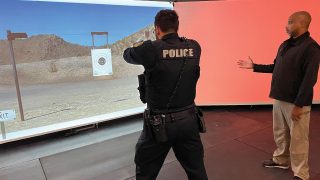
Many are discussing, even demanding, police reform, but no one seems to really know what it looks like. De-escalation is one of the topics at the center of this discussion. To me, the definition of reform in law enforcement is the enhancement of current practices and concepts that allows law enforcement to secure public safety while minimizing the risk of injury to the community, the offender and law enforcement. The concepts and practices of de-escalation are not new. They have, however, gone by different names in the past 20 or so years. Some of those past titles are verbal judo and tactical communication. That said, there is always room for enhancements in how de-escalation techniques are implemented.
The concepts and practices of de-escalation are the cornerstones of law enforcement training. They are necessary to mitigate the risk of injuries, not just to law enforcement but to those we interact with and serve.
Many in our communities believe de-escalation is always talking someone “down” from a volatile situation. I don’t blame them for this interpretation as it has been built over many years through legislators, “experts,” pundits and even fiction. The de-escalation process is much more. Ideally, every situation would be resolved with verbal communication and/or persuasion. However, there are circumstances when the “resistor” is not a willing participant in the de-escalation process.
Reform in the area of de-escalation comes through a better understanding of what de-escalation is and how it should be employed. De-escalation does not mean the absence or the non-utilization of physical coercion or physical control techniques, tools or weapons (i.e., taser, bean bags, 40mm, tactical withdrawal). On the contrary, it means understanding and utilizing the training, tools, tactics and techniques most appropriate to manage a crisis and mitigate the risk of injury. This is accomplished by utilizing the appropriate control technique(s) when the appropriate opportunity exists with a planned approach — when verbal communication fails or is poorly understood because the resistor is in crisis or under the influence and cannot or will not follow instructions.
The best way to know what is appropriate under the circumstances is by ensuring a strong understanding of the level of resistance encountered and what training, tools and tactics are most appropriate to de-escalate the situation. It should be noted that the de-escalation process will be hindered if all involved are not willing to participate in the process. In California, law enforcement is trained and required to attempt de-escalation techniques where those techniques will not put the safety of the community or the officers in jeopardy.
De-escalation factors
The outcome of any situation in which law enforcement is called to intervene is dependent on many factors. Of these factors, the most important is the willingness of those involved to cooperate with the de-escalation process. De-escalation occurs at different levels in every law enforcement interaction, from the traffic stop to the violent offender. The willingness of a subject to cooperate during a law enforcement interaction will guide the peace officer’s response to stabilize the situation and establish control to ensure the safety of all involved. In an ideal situation, gaining and maintaining control of any enforcement interaction is achieved without the need to employ any physical control techniques. Statistically, approximately 97% of all law enforcement interactions are resolved through de-escalation and compliance1 utilizing the key concepts of:
- Effective communication
- Emotional Intelligence
- Empathy
- Sound tactics
- Resource and plan development and implementation
- Teamwork
Using these concepts is most critical in situations involving people in crisis. In situations where a person is in crisis, law enforcement should look for methods to slow the situation and avoid “creating exigency.” This could allow for proper resources to arrive and plans put in place to minimize the risk of injury. However, in some cases, these de-escalation techniques may be prohibitive because the subject “compresses time,” causing an immediate response by law enforcement in order to prevent injury or death to the officer or others. Law enforcement must also recognize early intervention may prevent an escalation of physical control techniques if intervention is delayed. Sometimes the best intervention is no intervention — a “tactical withdrawal.” The practice of a “tactical withdrawal” is often difficult for officers who have been trained to solve problems. Tactical withdrawal must be normalized as a viable solution.
The de-escalation process
The first step in the de-escalation process is determining the severity of the crime, if any, and the risk to public safety if the person is not apprehended or controlled immediately. This determination can be somewhat subjective. Expectations should be relayed to a supervisor, patrol officer or deputy through department-approved training. This training must include current law, best practices and the resources available to that particular agency.
Oftentimes, a radio call is confused with an obligation to act, even detain, a person who is being reported to police because they are acting erratic but have not committed a crime. This type of call requires evaluation but may not demand a response or interaction with the subject of the radio call.
An example of this type of call is those calls to “investigate” people suffering from mental illness. More often, a radio call will be broadcast of a person walking down the street with a stick, pipe, knife or some other object that a community member deems “out of the norm.” However, no crimes have been committed, or the subject’s behavior did not warrant a detention. In these cases, interaction with the person may unnecessarily escalate the situation, creating an urgency.
If a detention is made or attempted without sufficient cause, any techniques used to affect the detention could be deemed excessive and illegal. This could create an unnecessary risk to law enforcement, the subject and the community. In certain cases, those witnessing the interaction may believe it was based on bias or motivated by inappropriate factors. Deciding when to interact with someone is based on an articulable set of circumstances and facts. If these circumstances exist and an interaction is warranted, there are steps law enforcement can take to limit the risks through de-escalation tactics.
The ability to anticipate the actions of others may be accomplished using strong, pre-engagement information-gathering techniques. Using training, experience and available resources (i.e., dispatchers, reporting parties, past incidents, clinicians) can enhance decision making in the highly ambiguous situations officers are faced with every day.
The five A’s approach
The five A’s can be a very useful guide to employing the proper de-escalation techniques. The five A’s can be employed rapidly or over time and include:
- Assess. Pre-engagement information gathering. Even en route to an incident, supervisors and officers should ask questions through dispatch and other resources to get as much information as possible to enhance decision making.
- Assemble. Based on the information gathered, begin forming plans and summon the resources necessary to implement the plans. Minimize threats with good tactics and appropriate application of resources. Whenever possible, engagement should be made only with adequate preparation.
- Anticipate. Based on the knowledge gathered and plans put in place to manage the incident, anticipate potential outcomes. This is critical in developing contingencies to mitigate those likely outcomes, especially outcomes with unfavorable consequences.
- Announce. Announce the plan. This should be done over the radio so all elements involved in the plan know the plan will be set in motion. It allows others involved to halt the plan if new information becomes known or it is not understood. After the plan is set in motion, periodic situational updates should be announced to provide others insight into the progress. The “announce” component is additionally important as it provides a record (along with body-worn camera footage, if available) of the plan for later review or litigation.
- Act. Put your plans in motion and be prepared to adjust based on anticipated and unanticipated outcomes. If possible, do not implement a plan until all elements are in place. Slowing the incident down is the best way for law enforcement to control the pace of the engagement process.
The five A’s cycle should be used as many times as necessary until a desired resolution is reached. Each of the components of the five A’s is critical to the others.
It has been said that hindsight eliminates all the variables of an incident. Law enforcement can also limit the variables at the onset and during an incident with a sound training approach and a clear understanding of department expectations. After all, human beings are one of the most unpredictable creatures on earth, which makes training, planning and critical thinking all the more important to minimize the risk of injury.
We cannot know what someone is thinking, planning or feeling, but we can gather as much information as possible to help us anticipate. With the resources available, we can develop enough information while using the five A’s to determine the best courses of action to a successful resolution.
In California, AB 392 requires officers to attend enhanced de-escalation training and to employ this training in the resolution of all incidents. I have used and witnessed these practices and concepts implemented, and they provide valuable insight to resolve critical incidents. As a trainer of these enhanced practices, I am convinced we are better equipped to manage these incidents, and we have saved lives as a result.
Some say the level of threat faced by law enforcement in a situation is only clear in retrospect. However, the more we know about the potential threats or risks will help us develop better contingency plans while clearly showing law enforcement’s dedication and understanding of the de-escalation process. Comments or feedback can be sent to the author at
responding2resistance@gmail.com.
Editor’s note: This article originally appeared in the March 2022 issue of PORAC Law Enforcement News.
As seen in the April 2022 issue of American Police Beat magazine.
Don’t miss out on another issue today! Click below:





